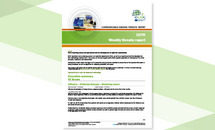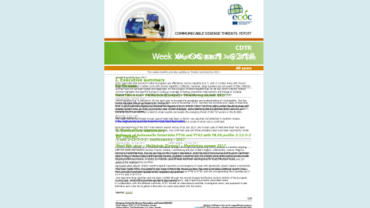ECDC Communicable disease threats report, Week 3, 11-17 January 2015
The ECDC communicable disease threats report is a weekly bulletin intended for epidemiologists and health professionals in the area of communicable disease prevention and control. Summarising information gathered by ECDC through its epidemic intelligence activities regarding communicable disease threats of concern to the European Union, it also provides updates on the global situation and changes in the epidemiology of communicable diseases with potential to affect Europe, including diseases that are the focus of eradication efforts.
Executive Summary
This issue covers the period from 11 to 17 January 2015 and includes updates on:
Seasonal influenza – Europe
In the second week of 2015, the intensity of influenza activity remained low in most countries in the WHO European Region, but the number of countries with increased intensity continued to rise compared to previous weeks.
The level of intensity of influenza activity was medium in fifteen of the 45 reporting countries, while the proportion of sentinel specimens testing positive for influenza virus increased to 28%, compared to 16% and 17% in the previous two weeks. The main influenza virus was type A, with A(H3N2) viruses predominating in most countries, based on primary care, laboratory-confirmed hospitalised cases and other sources of information.
As advised in previous seasons and in particular in a potentially severe season predominated by the A(H3N2) virus, physicians should always consider treatment or post-exposure prophylaxis with antivirals when treating influenza-infected patients and exposed individuals in risk groups.
Botulism in people who inject drugs – Norway and the UK
Since December 2014, there have been six cases of botulism in Norway (1) and Scotland (5) affecting people who inject drugs. In recent years, botulism in people who inject drugs has been reported in several European countries and the United States. Cases occurring in two EU Member States during a short time period indicate that a batch of heroin may have been contaminated with spores of the anaerobic bacterium Clostridium botulinum.
ECDC published a rapid risk assessment during the previous outbreak of botulism in Norway in October 2013 with conclusions and recommendations that remain valid for this event.
Ebola Virus Disease (EVD) – West Africa
An EVD epidemic has been on-going in West Africa since December 2013, mainly affecting Guinea, Liberia and Sierra Leone. The situation in the affected countries remains serious. Since the last CDTR published on 9 January 2015, and as of 12 January 2015, the World Health Organization has reported 357 additional cases in the affected countries and 185 additional deaths.
As reinforcement to help fight Ebola in the affected West African countries, the European Centre for Disease Prevention and Control is deploying four teams of French-speaking epidemiologists to support surveillance and response in Guinea.
On 18 January, the Government of Mali and WHO declared Mali Ebola free, 42 days after the last patient tested negative on 6 December 2014.
The latest updates are available on the ECDC pages on the Ebola outbreak in West Africa.
Middle East respiratory syndrome coronavirus (MERS-CoV)
Since April 2012, 974 cases of MERS-CoV have been reported by local health authorities worldwide, including 394 deaths. To date, all cases have either occurred in the Middle East, have direct links to a primary case infected in the Middle East, or have returned from this area.
Since last week, Saudi Arabia has reported five new cases of MERS-CoV infection. On 11 January 2015, Oman reported one additional case of MERS-CoV infection. The new case is a contact of the case previously reported on 8 January 2015.
Download






